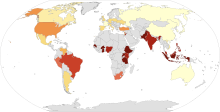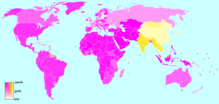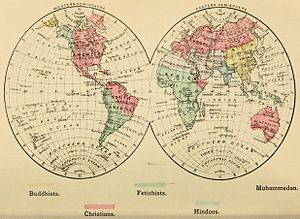
Muslims are people who adhere to Islam, a monotheistic religion belonging to the Abrahamic tradition. They consider the Quran, the foundational religious text of Islam, to be the verbatim word of the God of Abraham as it was revealed to Muhammad, the main Islamic prophet. Alongside the Quran, Muslims also believe in previous revelations, such as the Tawrat, the Zabur (Psalms), and the Injeel (Gospel). These earlier revelations are also associated with Judaism and Christianity, which are regarded by Muslims as earlier versions of Islam. The majority of Muslims also follow the teachings and practices attributed to Muhammad (sunnah) as recorded in traditional accounts (hadith).

Religion is a range of social-cultural systems, including designated behaviors and practices, morals, beliefs, worldviews, texts, sanctified places, prophecies, ethics, or organizations, that generally relate humanity to supernatural, transcendental, and spiritual elements—although there is no scholarly consensus over what precisely constitutes a religion. Different religions may or may not contain various elements ranging from the divine, sacredness, faith, and a supernatural being or beings.

Comparative religion is the branch of the study of religions with the systematic comparison of the doctrines and practices, themes and impacts of the world's religions. In general the comparative study of religion yields a deeper understanding of the fundamental philosophical concerns of religion such as ethics, metaphysics and the nature and forms of salvation. It also considers and compares the origins and similarities shared between the various religions of the world. Studying such material facilitates a broadened and more sophisticated understanding of human beliefs and practices regarding the sacred, numinous, spiritual and divine.
Christianity and other religions documents Christianity's relationship with other world religions, and the differences and similarities.
Religion in Africa is multifaceted and has been a major influence on art, culture and philosophy. Today, the continent's various populations and individuals are mostly adherents of Christianity, Islam, and to a lesser extent several traditional African religions. In Christian or Islamic communities, religious beliefs are also sometimes characterized with syncretism with the beliefs and practices of traditional religions.

World religions is a category used in the study of religion to demarcate at least five—and in some cases more—religions that are deemed to have been especially large, internationally widespread, or influential in the development of Western society. Buddhism, Christianity, Hinduism, Islam, and Judaism are always included in the list. Some scholars also include other religions in the category, such as the Baháʼí Faith, Sikhism, and/or Zoroastrianism. These are often juxtaposed against other categories, such as folk religions, Indigenous religions, and new religious movements (NRMs), which are also used by scholars in this field of research. Less dividing is the concept of major religious groups.
The Baháʼí Faith formed in the late 19th century in the Middle East, later gaining converts in India, East Africa, and the Western world. Traveling promoters of the religion played a significant role in spreading the religion into most countries and territories during the second half of the 20th century, mostly seeded out of North America by means of the planned migration of individuals. The Baháʼí Faith was recognized as having a widespread international membership by the 1980s, and is now recognized as the second-most geographically widespread religion after Christianity.

Religion in Egypt controls many aspects of social life and is endorsed by law. The state religion of Egypt is Islam, although estimates vary greatly in the absence of official statistics. Since the 2006 census religion has been excluded, and thus available statistics are estimates made by religious and non-governmental agencies. The country is majority Sunni Muslim, with the next largest religious group being Coptic Orthodox Christians. The exact numbers are subject to controversy, with Christians alleging that they have been systemically under-counted in existing censuses.

Religion has been a major influence on the societies, cultures, traditions, philosophies, artistic expressions and laws within present-day Europe. The largest religion in Europe is Christianity. However, irreligion and practical secularisation are also prominent in some countries. In Southeastern Europe, three countries have Muslim majorities, with Christianity being the second-largest religion in those countries. Ancient European religions included veneration for deities such as Zeus. Modern revival movements of these religions include Heathenism, Rodnovery, Romuva, Druidry, Wicca, and others. Smaller religions include Indian religions, Judaism, and some East Asian religions, which are found in their largest groups in Britain, France, and Kalmykia.
Asia is the largest and most populous continent and the birthplace of many religions including Buddhism, Christianity, Confucianism, Hinduism, Islam, Jainism, Judaism, Shinto, Sikhism, Taoism, and Zoroastrianism. All major religious traditions are practiced in the region and new forms are constantly emerging. Asia is noted for its diversity of culture. Hinduism is the largest religion in Asia with approximately 1.3 billion adherents.
Monotheism—the belief that there is only one deity—is the focus of the Abrahamic religions, which like-mindedly conceive God as the all-powerful and all-knowing deity from whom Abraham received a divine revelation, per these religions' traditions. The most prominent Abrahamic religions are Judaism, Christianity, and Islam. They, alongside Samaritanism, Druzism, the Baháʼí Faith, and Rastafari, all share a common core foundation in the form of worshipping Abraham's God, who is identified as Yahweh in Hebrew and called Allah in Arabic. Likewise, the Abrahamic religions share similar features distinguishing them from other categories of religions:
As of 2011, most Armenians in Armenia are Christians (97%) and are members of the Armenian Apostolic Church, which is one of the oldest Christian churches. It was founded in the 1st century AD, and in 301 AD became the first branch of Christianity to become a state religion.

Religion in Ethiopia consists of a number of faiths. Among these mainly Abrahamic religions, the most numerous is Christianity totaling at 67.3%, followed by Islam at 31.3%. There is also a longstanding but small Ethiopian Jewish community. Some adherents of the Baháʼí Faith likewise exist in a number of urban and rural areas. Additionally, there is also a substantial population of the adherents of traditional faiths.
Growth of religion involves the spread of individual religions and the increase in the numbers of religious adherents around the world. In sociology, desecularization is the proliferation or growth of religion, most commonly after a period of previous secularization. Statistics commonly measure the absolute number of adherents, the percentage of the absolute growth per-year, and the growth of converts in the world.
The term Abrahamic religion groups three of the major religions together due to their historical coexistence and competition; it refers to Abraham, a figure mentioned in the Hebrew Bible, the Christian Bible, and the Quran, and is used to show similarities between these religions and put them in contrast to Indian religions, Iranian religions, and the East Asian religions. Furthermore, some religions categorized as "Abrahamic" also share elements from other categories, such as Indian religions, or for example, Islam with Eastern religions.
For approximately a millennium, the Abrahamic religions have been predominant throughout all of the Middle East. The Abrahamic tradition itself and the three best-known Abrahamic religions originate from the Middle East: Judaism and Christianity emerged in the Levant in the 6th century BCE and the 1st century CE, respectively, while Islam emerged in Arabia in the 7th century CE.
Islam and Christianity are the most widely professed religions in Chad. Smaller populations of non-religious people as well as adherents of other faiths are also present.
According to the 2012 census, Islam is the most followed religion in Niger and is practiced by 99% of the population. According to Pew, roughly 80% of Muslims are Sunni of Maliki school of jurisprudence, whilst 20% are non-denominational Muslims Other religions practiced in Niger include Animism and Christianity.

Christianity is the majority religion in Cameroon, with significant minorities of the adherents of Islam and traditional faiths.

Adherents of Islam constitute the world's second largest religious group. A projection by the PEW suggests that Muslims numbered approximately 1.9 billion followers in 2020. Studies in the 21st century suggest that, in terms of percentage and worldwide spread, Islam is the fastest-growing major religion in the world, mostly because Muslims have more children than other major religious groups. Most Muslims are either of two denominations: Sunni or Shia. Islam is the majority religion in several subregions: Central Asia, Western Asia, North Africa, West Africa, the Sahel, and the Middle East. The diverse Asia-Pacific region contains the highest number of Muslims in the world, surpassing the combined Middle East and North Africa.
















